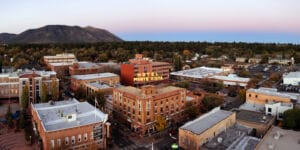Californians have been beating a path to the Grand Canyon State and moving to Arizona for more than the last decade – but it’s not exactly been a one-way street.
While close to 500,000 people moved from California to Arizona from 2010 to 2018, just over 308,000 people were moving in the other direction, according to state-to-state migration flow data released this fall by the Census Bureau.
The numbers show that Arizona continues to be a net importer of people, taking in 2.2 million new residents from other states since 2010, while losing 1.7 million to other states in that eight-year period.
They came from Maine – 4,182 for the period – to Hawaii – 18,993. And they went to every state, including 831 to West Virginia and 12,254 to Alaska.
Arizona is the No. 2 relocation destination for Californians
Buckeye had nation’s fastest growth, Phoenix added most people in 2018
Not surprisingly, the highest traffic was between neighboring California and Arizona, while Texas and Illinois sent 137,320 and 102,897, respectively. A little less expected was Washington, which fell between Texas and Illinois, sending 127,772 people south since 2010.
That didn’t surprise Garrick Taylor, spokesman for the Arizona Chamber of Commerce, who noted that Boeing has a large presence in both states, with a majority of its operations in Seattle as well as a facility in Mesa.
Taylor said states like California and Washington are “overtaxed and over-regulated,” making it difficult to operate a business and attract employees. He credited Arizona’s steady economy for playing a huge part in attracting the young workforce that is moving to Arizona in droves.
“Job growth is driven by very intentional and specific policy decisions lawmakers and governors make,” Taylor said. “Gov. (Doug) Ducey and Arizona lawmakers are making Arizona attractive to economic growth, and doing a good job based on the data.
“Arizona has jobs other states are clamoring for,” he said. “A lot of states don’t have the dynamism that ours does.”
That doesn’t mean the state always came out ahead in the population migration game. Arizona posted a net loss of residents from 2010 to 2018 to Texas, Georgia, South Carolina, the District of Columbia, Idaho, Alabama and Connecticut. The shift ranged from a 25,299 gain for Texas to 118 for Connecticut.
David Plane, professor emeritus of geography and development at the University of Arizona, said he was not surprised by the data, though he warned that the state’s snowbirds are often mistakenly included in this survey if they have lived in Arizona for three or more months.
He said Arizona’s booming population can be largely attributed to its reputation as a retirement destination.
“We have a lot of people retiring now, baby boomers are coming of age,” said Plane. “This baby boom retirement phenomenon is going to go on for a while.”
Baby boomers are the generation of Americans born between 1946 and 1964. Plane said about half of the baby-boom generation has retired thus far, so Arizona’s retiree population will only continue to increase.
But boomers are not the only ones making their way to Arizona.
Michael Guymon, vice president of the Tucson Metro Chamber, agreed with Taylor and Plane that Arizona’s low cost of living and climate make it a great place to do business – businesses that need workers. He said Tucson employers work hard to attract potential employees to the area, and that contributes to increased migration.
“The labor market is tight so if they can’t find talent locally, they have to import from other states,” he said.
While Guymon cautioned that continued growth could be a “strain on our resources” if not properly planned for, he welcomes the population boom.
“If you’re a community that’s not growing, you’re dying,” he said.
Story by Lindsay Walker, Cronkite News



